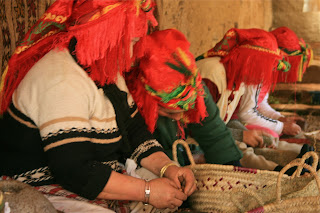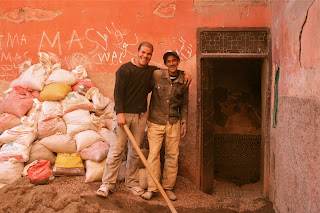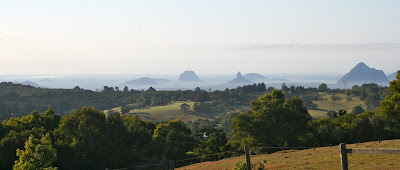Marrakech Part 2; Moroccan Woman and Berber Man
 |
| Rue Bab Agnaou |
My most prominent observation of the streets in Marrakech was that they are a domain that belong to the men. I’m only guessing, but I would hazard at 70-80% of the pedestrian traffic in Marrakech would have been male. This statistic was most notable in the souks, cafes, restaurants and majority of the retail outlets in those locations that you could access on foot. Any cafe or restaurant within one hundred metres of a mosque or citadel would be totally inhabited by men unless some western tourists happened into one of these ‘men only’ establishments without taking too much notice of the clientele present. Women solely operating a retail outlet were the exception.And just as noticeable was the quality of the service from these businesses and the lack of hard sell tactics.
Of the thirty five million people living in The Kingdom of Morocco, ninety nine percent are of Arab-Berber origins. Islam is the dominant religion with 0.2 percent of the population being Jewish. The cultural diversity throughout old Marrakech is obvious and on the surface, tolerated. The Berber people lived in Morocco long before the arrival of Arabic tribes. The Berbers still maintain their own language although it is not recognized by the Moroccan government, and keep alive their traditional customs and music.
 |
| Where we bought our Moroccan fabrics |
The main roads throughout the Medina overflow with aging, cream coloured, diesel Mercedes Benz taxis, donkey drawn carts, horse drawn carriages, motor scooters and 100 cc motor bikes and pedestrians. Outside the walls of the Medina the new style, Moroccan designer housing districts have sprung up, complete with billboards, western brand name shopping centres and parking bays filled with modern European cars. Motor scooters and bikes still appear to be the dominant form of transport outside the wall for residents to get around. One of our drivers told us a story about Muslim women but I don’t think it is appropriate to repeat it here. The content of the story may, however, reflect a dominant attitude of a patriarchal society.
Jo and I managed to meet and talk to a few local women on our travels through the city and adjoining rural landscape. While Jo was waiting to have henna tattoos put on her hands we met two groups of young women. One group were from a small village between Casablanca and Marrakech. They were interested in finding out where we were from and our opinions so far of Marrakech and Morocco. They had travelled to Marrakech for a pampering stay at a day spa and shopping, apparently something which Moroccan women love to come to Marrakech and do. They were outgoing and only too happy to share about their opinions and views on a range of subjects. The other group were students from a school in Casablanca who had been snow skiing in the nearby Atlas Mountains the day before. We spoke with the daughter of their teacher. Her name was Khadija. She is currently studying Economics and Business at a university in Casablanca and offered to show us around Casablanca if we had time to visit there.
 |
| The women from the village outside Casablanca |
 |
| The girls from Casablanca |
 |
| Jo with the henna artist |
 |
| The dentist |
 |
| Berber weekly markets |
 |
| Berber chicken man |
Further up the road to Ourika we stopped in at the village of Askine where a women’s co-operative known as Aitma Sens has been founded. This co-operative employs most of the women in the village processing locally grown argan nuts. On site in the village they extract the oil and use it to produce a range of natural cosmetic products. The village women are involved in all aspects of the business from the picking to the marketing, product demonstration and sele to the public at the Aitma Sens centre in Askine. The Berber woman who showed us through the centre told us that she loved the opportunities that she now had as a member of the women’s co-operative. She also said that she felt the current Moroccan king and the new realization of their people towards a working democracy has improved the situation for Moroccan women.
Another woman Jo and I met owned a French style clothes boutique in the Qzadria district of the Medina. Originally from Provence in France she is now married to a Moroccan man and has lived in the Marrakech Medina for six years. This lady explained how she has worked hard at being successful in her little business but she was still a minority in a male dominated retail interface. She also felt that there was progress being made for women in Morocco but it was only on the beginning of the road forward. Yes, the King had good qualities and a genuine respect for women. Yes, corruption by politicians and government employees and the ill-treatment of women had been exposed. But still many class issues remained in Morocco and no matter what political changes had taken place, women were not in the same class as the men. The word subjugation comes to mind.
 |
| Tatza - Traditional family hamman |
 |
| Tatza |
 |
| Women's co-operatice Askine |
Another woman Jo and I met owned a French style clothes boutique in the Qzadria district of the Medina. Originally from Provence in France she is now married to a Moroccan man and has lived in the Marrakech Medina for six years. This lady explained how she has worked hard at being successful in her little business but she was still a minority in a male dominated retail interface. She also felt that there was progress being made for women in Morocco but it was only on the beginning of the road forward. Yes, the King had good qualities and a genuine respect for women. Yes, corruption by politicians and government employees and the ill-treatment of women had been exposed. But still many class issues remained in Morocco and no matter what political changes had taken place, women were not in the same class as the men. The word subjugation comes to mind.
 |
| The lady from the boutique |











Comments
Post a Comment